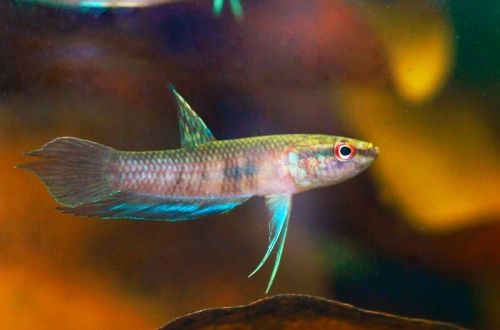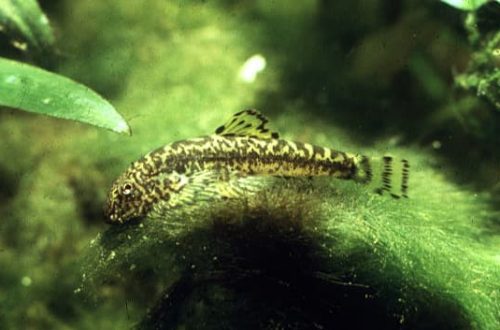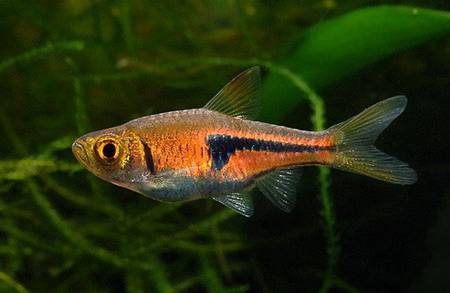
cockerel dimidiata
Betta dimidiata or Cockerel dimidiata, scientific name Betta dimidiata, belongs to the Osphronemidae family. The word dimidiata in the name of the species is translated from Latin as “halved”, indicating the modest size of this fish. Relatively easy to maintain, although a novice aquarist may have some problems in terms of water treatment. Peaceful and compatible with other species.

Contents
Habitat
It comes from Southeast Asia from the island of Borneo. Wild populations are known only in the upper basin of the Kapuas River, including the region of the Danau-Sentarum lakes, located in the Indonesian province of West Kalimantan. Inhabits small forest streams and rivers only centimeters deep. The bottom is covered with a layer of fallen leaves, twigs and other plant debris. Little light penetrates through the dense crown of trees, the water surface is poorly lit, so aquatic plants are practically not present, but coastal vegetation from among mosses and ferns forms dense clusters. Often the water takes on a brownish hue, which is imparted by humic acids and other substances released by decaying organic material.
In certain seasons of the year, the already shallow reservoirs begin to dry up, leaving the fish in tiny puddles, where they are waiting for the rains.
Brief information:
- The volume of the aquarium – from 40 liters.
- Temperature – 22-27°C
- Value pH — 5.2–6.5
- Water hardness – 1–5 dGH
- Substrate type – any
- Lighting – subdued
- Brackish water – no
- Water movement – weak or absent
- The size of the fish is 3–4 cm.
- Food – any food
- Temperament – peaceful
- Content – singles, pairs or in a group
Description
Outwardly, it resembles the closely related species Cockerel krataios, which was previously considered a variety of Betta dimidiata. Both fish are similar in appearance both in color and in size – adults reach a length of 3–4 cm. They differ in the shape of the tail, in the first it is rounded, and in the second it is pointed along the central rays.
Males, unlike females, are larger, the tips of the fins are elongated, and there are turquoise shades in the color. The main color of the females is gray, alternating light and dark stripes are noticeable in the body pattern.
Food
Acclimatized fish and those that grew up in the artificial environment of aquariums have adapted to the intake of popular dry food in the form of flakes, granules. A number of manufacturers produce specialized food for Betta fish, used as the basis for a daily diet. A good addition to the diet will be live or frozen brine shrimp, daphnia, bloodworms and similar products.
Maintenance and care, arrangement of the aquarium
The optimal size of an aquarium for one or two fish or a small group starts from 40 liters. When keeping a Dimidia Cockerel, it is important to provide conditions similar to its natural habitat. Of key importance is the hydrochemical composition of the water, which must be maintained at low pH and dGH values and to prevent the accumulation of organic waste that can disrupt the normal flow of the nitrogen cycle. For this purpose, a weekly replacement of part of the water (15–20% of the volume) with fresh water is carried out, organic waste is removed in a timely manner and other procedures are carried out. The uninterrupted operation of the installed equipment also contributes to maintaining the biological balance in the closed ecosystem of the aquarium, this primarily applies to the filtration system.
It is worth remembering that the filter is a source of internal flow, and fish that live in nature mainly in stagnant water bodies are not very adapted to it, so when choosing a specific model, you should give preference to one that does not cause excessive water movement. In some cases, a regular airlift filter with a sponge will do.
It is recommended to use a closed aquarium so that a layer of warm moist air remains under the “lid”, otherwise there is a high risk of damage to the specific respiratory organ that exists as an addition to the gills of Labyrinth fish.
The format doesn’t really matter. For example, many breeders and pet stores keep fish in half-empty tanks. Of course, this is not an ideal environment, but acceptable. In a home aquarium, it is desirable to use some natural decorations, such as driftwood and live aquatic plants, including floating ones, which are an additional means of shading.
Behavior and Compatibility
Peaceful calm fish, although there is a certain rivalry between males, but it does not come to serious skirmishes. Compatible with other non-aggressive species of comparable size.
Breeding / breeding
Betta dimidiata and some other fighting fish have evolved an atypical way of protecting future offspring. They do not create masonry and do not spawn among plants or on the ground. During spawning, accompanied by a kind of “hug dance”, the male takes all the fertilized eggs into his mouth, where they will stay for the entire incubation period – 10-14 days. The fry appear fully formed and ready to receive microscopic food.
Breeding in a home aquarium is possible, fraught with some difficulties and is unlikely to be within the power of a novice aquarist.
Fish diseases
The cause of most diseases is unsuitable conditions of detention. A stable habitat will be the key to successful keeping. In the event of symptoms of the disease, first of all, the quality of the water should be checked and, if deviations are found, measures should be taken to correct the situation. If symptoms persist or even worsen, medical treatment will be required. Read more about symptoms and treatments in the Aquarium Fish Diseases section.





